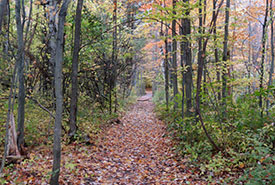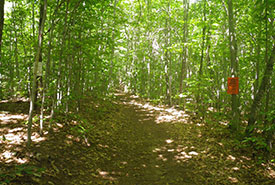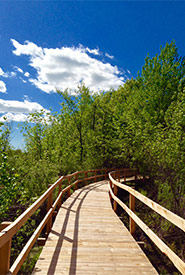Montérégie
The Clarke Sydenham Nature Reserve and Le Nichoir
A refuge for urban wildlife

Clarke Sydenham Nature Reserve (Photo by Jo-Annie Gagnon)
Less than 30 kilometres from the Island of Montreal, in the town of Hudson, a little-known gem of nature awaits: the Clarke Sydenham Nature Reserve, protected by NCC since 1991. Panels installed along the trails teach visitors about the reserve’s different habitats, which shelter a wide variety of birds, including prairie grassland, which is hospitable to rural bird species, and a mature pine and oak forest.
The property is also developed by the activities of Le Nichoir, a wild bird rehabilitation centre. Le Nichoir provides proper care and treatment for injured or orphaned wild birds and releases them back into their natural habitat. Each year, more than 1,600 birds are admitted to the centre and cared for. Educational programs, family activities and public events are organized all year long.
See below for directions:
Chemin-Saint-Georges Nature Reserve (Rigaud)
A forest oasis in the heart of Mont Rigaud (trail)

Chemin-Saint-Georges Nature Reserve, Rigaud, Quebec (Photo by NCC)
Drive an hour out of Montreal to reach this mature forest in the Mont Rigaud forest block. This small island, with a lush forest typical of southern Quebec, is home to many species of flora and fauna that were previously spread all over the region.
Dominated by sugar maple and American beech, this forest is also home to white pine and butternut trees, which are also endangered in Quebec. The natural characteristics of this reserve offer potential habitat for barred owl and southern flying squirrel, a species of special concern. The 500-metre-long trail is open year-round for hiking, as well as cross-country skiing and snowshoeing in winter.
Click here to view the map
See below for directions:
Tourbière-de-Venise-Ouest Nature Reserve in (Venise-en-Québec) (trail)
The part of the Venise-Ouest peatland that is located in Venise-en-Québec can be hiked year-round thanks to boardwalks criss-crossing the site. An information panel at the entrance and several other interpretive panels along the trail will deepen your appreciation and enjoyment of the area.

Tourbière-de-Venise-Ouest Nature Reserve, Quebec (Photo by NCC)
This site has been recognized by the Quebec government since 2011 as a nature reserve on private land due to its exceptional ecological features. One notable species found here is the bog fern, which is designated as threatened in Quebec. A significant population of around 10,000 plants represents the largest occurrence in Quebec of this fern, which has only been observed in three other locations in the province. Furthermore, the Venise-Ouest peatland helps absorb water overflow during spring flooding of Lake Champlain and filters some of the water that empties into Missisquoi Bay.
The site can be reached easily via route 202 to Venise-en-Québec.
This Nature Conservancy of Canada property is part of a large wetland northeast of Missisquoi Bay, covering 1,398 acres (566 hectares). The entire area is of vital significance, as it shelters a great number of threatened or vulnerable species and plays a vital ecological role. As of 2015, 67 per cent of this wetland has been protected, of which 390 acres (158 hectares) is protected by NCC.
Click here to view the trail map.
See below for directions



